|
 |
 |
|
  King Henry, VIII King Henry, VIII
Michael Samuel Marzella
Henry Tudor, named after his father, Henry VII, was
born by Elizabeth of York June 28, 1491 in Greenwich Palace. He was
the second son, and not expected to become king. His older
brother, Arthur, Prince of Wales, married Catherine of Aragon in
November 1501 when Henry was 10 years old. Shortly after the wedding,
Arthur and
 Catherine went to live in Wales, but four months after the
marriage began, Arthur died. A treaty was signed that would
allow Catherine to marry the next heir to the throne -- Prince Henry.
Until then, Catherine's parents, Ferdinand and Isabella of Spain would
send over 100,000 crowns worth of plate and gold as a wedding gift and
Henry would pay the agreed upon dowry. Catherine went to live in Wales, but four months after the
marriage began, Arthur died. A treaty was signed that would
allow Catherine to marry the next heir to the throne -- Prince Henry.
Until then, Catherine's parents, Ferdinand and Isabella of Spain would
send over 100,000 crowns worth of plate and gold as a wedding gift and
Henry would pay the agreed upon dowry.
Henry was just shy of 18 years old when he became king
upon the death of his father on the 22nd of April 1509. Henry
succeeded to the throne, having been preparing for it from the time of
his older brother Arthur's death. His accession was hailed with
universal acclamation.
 At age 30, he was not the image that we
usually call to mind when we hear the name Henry VIII. He was handsome
and athletic. He was tall and had a bright red-gold cap of hair and
beard. Henry's marital career is probably the thing for which he
is most known. At age 30, he was not the image that we
usually call to mind when we hear the name Henry VIII. He was handsome
and athletic. He was tall and had a bright red-gold cap of hair and
beard. Henry's marital career is probably the thing for which he
is most known.
The six wives of Henry VIII

1
Catherine of Aragon 2
Anne Boleyn 3
Jane Seymour

4
Anne of Cleves 5
Catherine Howard 6 Catherine Parr
  |
|
|
  Queen Catherine
Parr Queen Catherine
Parr
6th and final wife of King Henry VIII
Mouse-over photo for another view
of the Queen with Sir Vincent Roswell
Catherine was born around 1512 at Kendal Castle in Westmorland, North
West England, where her ancestors had resided since the fourteenth
century. She was the eldest child of Sir Thomas Parr and Lady Maud
Green. She had a younger brother, William Parr, and
a sister, Anne Parr, Lady Herbert.
As a child, Catherine was groomed to be an exemplary noblewoman with
a love of learning and a modest demeanor, which were to serve her well
throughout her life. Out of the many suitors for
Katherine's hand, her mother finally chose
Edward, second
Baron Borough of Gainsborough in Lincolnshire. At the time of the
marriage in 1527, he was around 63 years old, old enough to be
Catherine's grandfather—Catherine was 15. While the idea is revolting
to us today, and doubtless was to Catherine herself, such disparately
aged matches were not unusual in the day. Money, land, and title
made marriages, and details of age or agreeability to both partners
rarely entered the equation. Catherine Parr moved to live with her
husband as stepmother to his children from his previous marriage;
children who were old enough to have fathered her. Lord Borough died
in 1528 and so Catherine was widowed at about age 16.
In 1529, Catherine's mother passed away, leaving a
considerable fortune to Katherine. In the summer of 1534, she married
John Neville, 3rd Baron Latymer of Snape, North Yorkshire. He had been
twice married, he was 41, she was 22. As Lady Latimer, Catherine moved to her husband's
household at Snape Castle in Yorkshire. In 1536, during the
Pilgrimage
of Grace, Catherine was held hostage by northern rebels, along with
her two stepchildren. From the autumn of 1542, Lord Latimer's health began to
fail. In early 1543, when Latimer's impending demise became apparent,
King Henry VIII began to court Katharine. After Lord Latimer's
death, Catherine stayed on at court, not for Henry, but because of a
flirtation with the dashing Sir Thomas Seymour. He was thirty-seven to
her thirty-one, brother of the late Queen Jane Seymour, and uncle to Prince
Edward. They were mutually attracted, and began to discuss marriage. The King, however, wanted Catherine for himself and was jealous.
Catherine
was not interested and had no interest in becoming Queen, or
indeed wife number six to a man of questionable track record. In May
1543, King Henry, customarily ruthless, sent Thomas Seymour to Brussels on a
permanent embassy, and began his advances in earnest. Around July, the
King proposed to Katharine. Feeling she hadn't much choice, she
finally acquiesced. The marriage took place in a private ceremony on
July 12, 1543, at Hampton Court.
 . .
Following Henry's death in 1547, Catherine was able to
marry her old love,
Thomas Seymour, 1st Baron Seymour of Sudeley and
Lord High Admiral. Having had no children from her first three
marriages, Catherine became pregnant for the first time, by Seymour,
at age thirty-five. Catherine gave birth to her only child
- a daughter, Mary Seymour - on 30 August 1548, but Catherine died
only six days later, on 5 September 1548, at Sudeley Castle in
Gloucestershire, from what is thought to be puerperal fever or
puerperal sepsis, also called childbed fever.
Official Webbe Site of the British Monarchy 
|
|
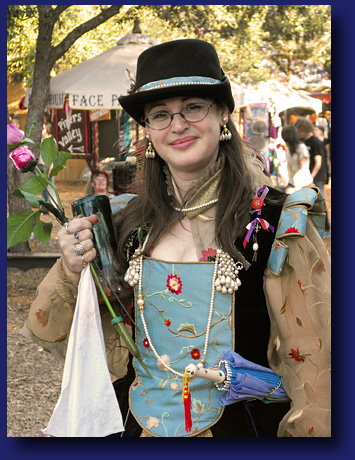 |
|


Lady Catherine Willoughby
Duchess of Suffolk, a.k.a.
Suzanne
Maddocks
|
Lady in Waiting to Queen
Catherine of Aragon (Henry VIII's 1st wife) and close friend of Queen
Catherine Parr (Henry VIII's 6th wife)
Mouse-over photo for another view
Noted for her wit, sharp tongue, and devotion to
learning, by the last years of Henry VIII's reign the Duchess of
Suffolk was also an outspoken Protestant. She became a close friend of
Henry's last Queen, Catherine Parr, particularly after the Duke died
in 1545, and was a strong influence on the Queen's religious beliefs.
 Less than a year after Queen Catherine Parr
Seymour's death, her widower Thomas Seymour was beheaded for
treason; their infant daughter Mary Seymour was taken to live
with Catherine Willoughby. After a year and a half, Mary's
property was restored to her by an Act of Parliament, easing the
burden of the infant's household on the Duchess. The last
mention of Mary Seymour on record is on her second birthday, and
although stories circulated that she eventually married and had
children, most historians believe Mary Seymour died as a child Less than a year after Queen Catherine Parr
Seymour's death, her widower Thomas Seymour was beheaded for
treason; their infant daughter Mary Seymour was taken to live
with Catherine Willoughby. After a year and a half, Mary's
property was restored to her by an Act of Parliament, easing the
burden of the infant's household on the Duchess. The last
mention of Mary Seymour on record is on her second birthday, and
although stories circulated that she eventually married and had
children, most historians believe Mary Seymour died as a child |


|
|
|
|
|
|
 |
 |
|
  Lady Anne Parr Herbert Lady Anne Parr Herbert
Countess of Pembroke
a.k.a.
Joni
Nathan
Mouse-over photo for another view
|
Lady in Waiting to each of Henry VIII of
England's six wives. Anne Parr was the daughter of Sir Thomas Parr
and Maud Green, and thus, a sister of Queen Catherine Parr and
William Parr. Anne became a maid of honor to Queen Jane Seymour. In
early 1538, Anne married William Herbert. As Lady
Herbert, she was keeper of the queen’s jewels to Catherine Howard,
although she left court briefly to give birth to h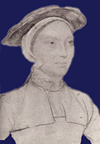 er first child, Henry. When her sister
Catherine became Henry VIII’s sixth queen in 1543, Anne returned to
court. She and William Herbert had two more children,
Edward and Anne and used Baynard’s Castle as their London residence. er first child, Henry. When her sister
Catherine became Henry VIII’s sixth queen in 1543, Anne returned to
court. She and William Herbert had two more children,
Edward and Anne and used Baynard’s Castle as their London residence.
|
 
|
|
|
  Lady Maud
(Matilda) Parr Lane Lady Maud
(Matilda) Parr Lane
a.k.a.
Cousin and Lady in Waiting to Queen Catherine Parr
|
Maud's parents were Sir William Parr and Mary
Salisbury. Sir William Parr was a brother of Thomas Parr, and Thomas
was the father of Queen Catherine Parr. On the death of Maud's husband Sir Ralph Lane, Maud Parr
Lane was brought into the royal household and was known as Lady Lane.
Her cousin, Queen Catherine Parr, used her influence on her husband,
King Henry VIII, to
secure land for the widowed Maud Lane. Her son, Ralph Lane, is
best remembered for his unsuccessful attempt to colonize Roanoke
Island at the request of Sir Walter Raleigh, and for serving as its
Governor. |
About her son, Ralph Lane
Parr
of Kendal Genealogy  |
|
|
 |
|
 
|
Lady Elizabeth Norrington
a.k.a. Cristine Antolak
Lady in Waiting to Queen Catherine Parr
Niece of
Commodore James Norrington
Looking for a Gentleman |
  |
|
|
|
|
|
|
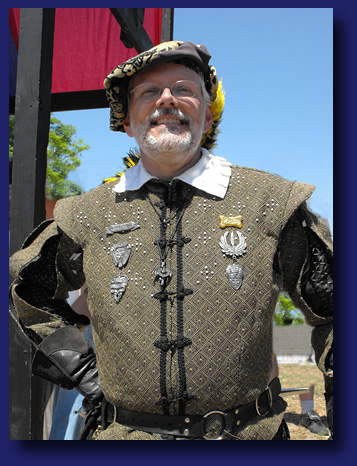 |
 |
|


Lady Catherine Willoughby
|
Catherine was born in 1519, probably at court, to Maria
de Salinas and William Willoughby, 11th Baron Willoughby de Eresby.
In 1526, Lord Willoughby de Eresby died, and Catherine, as his only
surviving child, inherited the Barony and an income of 15,000 ducats a
year at the age of seven. Wardship of the girl fell to the King, who
sold it to his brother-in-law, Charles Brandon, the Duke of Suffolk. A battle
over her inheritance ensued with her uncle, who argued that the
estates and title should pass to him rather than a female heir. After
this issue was resolved, Catherine was betrothed to the Duke's son and
heir, the Earl of Lincoln. However, on the death in 1533 of the Duke's
wife, Mary Tudor (sister of Henry VIII and Queen Dowager of France),
the Duke chose to marry Catherine himself. Catherine and Charles had four children: Henry, Charles, Susan Bertie and Peregrine Bertie. |
  |
|
| |
|
 |
|
  Emperor Charles V -- Holy Roman Emperor Emperor Charles V -- Holy Roman Emperor
a.k.a. Tim Fraley
King of the Romans, Italy, France, and Spain
Archduke of Austria, Lord of the Netherlands (Titular)
Duke of Burgundy, King of Germany
Mouse-over photo for
another view
|
Ruler of the Holy Roman Empire from 1519 and, as
Charles I of Spain, of the Spanish realms from 1516 until his
abdication in 1556. Born in 1500, he was the son of
Philip I of Castile (Philip the Handsome) and
Juana of Castile (Joanna the Mad of Castile). His paternal
grandparents were the Holy Roman Emperor Maximilian I and Mary of
Burgundy, whose daughter Margaret raised him. His maternal
grandparents were Ferdinand II of Aragon and Isabella I of Castile,
whose marriage had first united their territories into what is now
modern Spain, and whose daughter Catherine of Aragon (Charles' aunt)
was Queen of England and first wife of Henry VIII. His cousin was Mary
I of England, who married his son Philip. On the eve of his death in 1558, his realm, which
has been described as one in which the sun never sets, spanned almost
4 million square kilometers. As the heir of four of Europe's leading
dynasties – the Habsburgs of Austria, the Valois of Burgundy, the Trastamara of Castile and the House of Aragon – he ruled over
extensive domains in Central, Western and Southern Europe, as well as
the various Castilian (Spanish) colonies in the Americas. |
  |
|
|
 
|
As the first King to reign in his own right over both
Castile and Aragon he is often considered as the first King of Spain.
Charles provided five ships to Ferdinand Magellan after the Portuguese
captain was repeatedly turned down by Manuel I of Portugal. The
commercial success of the voyage, which temporarily enriched Charles
by the sale of its cargo of cloves, laid the foundation for the
oceanic empire of Spain. During Charles' reign, the territories
in New Spain (The Americas) were considerably extended by
conquistadores like Hernándo Cortés and Francisco Pizarro, who caused
the Aztec and Inca empires to fall in little more than a decade.
Combined with the Magellan expedition's circumnavigation of the globe
in 1522, these successes convinced Charles of his divine mission to
become the leader of a Christian world that still perceived a
significant threat from Islam. Of course, the conquests also helped
solidify Charles' rule by providing the state treasury with enormous
amounts of bullion. In 1550 ,
Charles ,
Charles
 convened
a conference at Valladolid in order to consider the morality of the
force used against the indigenous populations of Spanish America.
Charles V is credited with the first idea of constructing a canal
across the isthmus Panama as early as 1520. convened
a conference at Valladolid in order to consider the morality of the
force used against the indigenous populations of Spanish America.
Charles V is credited with the first idea of constructing a canal
across the isthmus Panama as early as 1520.
Charles suffered from an enlarged lower jaw, a
deformity which became considerably worse in later Habsburg
generations and became known as the "Habsburg
Jaw." The deformity was caused by multiple generations of
ancestral inbreeding, which was common in royal families back in those
times, in order to keep the bloodline "pure". |
  |
|
 |
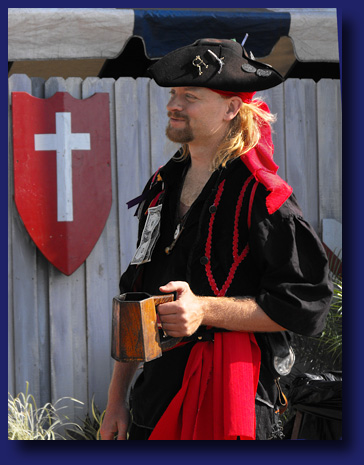 |
|
|
|
Captain Red "Swash" Rogers (Thomas Zadoyko) of the comedy team of
"Buckle & Swash" |
|

|
 |
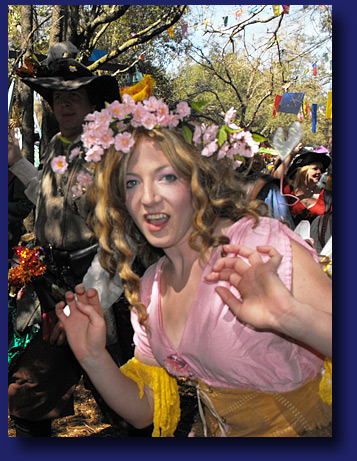 |
|
Donalan, the
Oak Fairy
Don
Sankovitch
Mouse-over photo for another view
Don is from Fairpoint, Ohio and is a 3rd
grade stars elementary school teacher at Gulfport Montessori Elem.
School. He obtained his Masters Degree in Elementary Education
from Ohio State University in 2002.
See his MySpace Photos |
|
|
|
 |
 |
|
|
|
Rodrigo - Beer Hawker
Rodrigo enjoys collecting antique books, renaissance
faires, World War 2 aircraft, and anything to do with history.
He is a University of Alabama graduate with a Masters Degree in Health
Administration and works as a medical practice administrator.
Visit his MySpace Site |
|
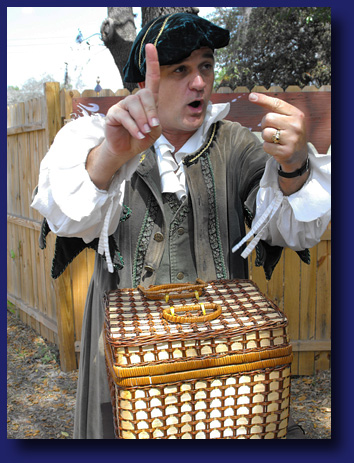 |

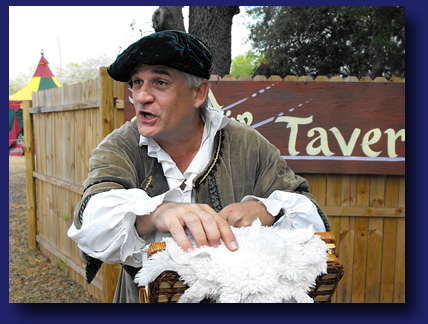 |
|
Ebeneezer
Bay, Renaissance Pitchman
Ebeneezer Bay is played by Howard Koutney,
Owner/Operator of Forte' Talent Inc. When he is not entertaining the
masses at the Bay Area Renaissance Festival, he provides D.J. and
Master of Ceremonies services for Weddings and corporate events.
Howard has been a Professional Disc Jockey & Emcee since 1981.
He's a former Nightclub D.J who played at The Ocean Club Tampa, Baja
Beach Club Tampa and many other locations statewide. He was also
an on-air personality for Smooth Jazz, WSJT 94.1, a producer for
Sports Radio 820 "The Team" and Board operator for 102.5 WHPT "The
Point." |
|
|
 |
 |
|
Offering a seemingly endless line of
Renaissance era versions of today's products, he'll have you
convinced you just can't do without them!
As well as being a D.J., Howard has also worked as an
interactive performer with the
Wiseguys,
portraying characters such as Indiana Jones, Dracula, Gomez Addams,
and many others. He has also hosted many game shows for trade
shows and conventions in the Orlando and Tampa area. Howard
brings a vast array of talent and a wide range of experience to his
new endeavor,
Forte Talent, Inc. |
|

|
 |
 |
|
Looney Lucy, the Zany bag-lady
a.k.a.
Lynda Kavy of Empty Hats
Lynda is one of four members of the
Celtic band Empty Hats and a character actress at Renaissance
and Medieval Faires. A mathematics major until her junior year in
college, she took an acting class; transferred to an acting college
and moved to Manhattan as soon as she graduated. Performing in
Off-Broadway venues like the Provincetown Theatre Company and the
13th Street Theatre, she continued to learn her craft in such shows
as Israel Horovitz’s “Line” while working here and there to make
ends meet. In the mid 80’s, she and a friend went to Atlantic City
where she interviewed for a new program being put together to
entertain customers arriving by bus at the Tropicana Casino. By the
time she met Carl Asch, she was doing a morning radio show and
performing at the Trump Castle. Carl was already performing on
the Faire circuit and for several years encouraged Lynda to join
him. (From Fairenews.com)
Meet Looney Lucy
Looney Lucy's website |
|
|
 |
 |
|
|
|
Fern, a tree Fairy
(Paige
Crane)
Mouse-over photo for another view |
|
 |
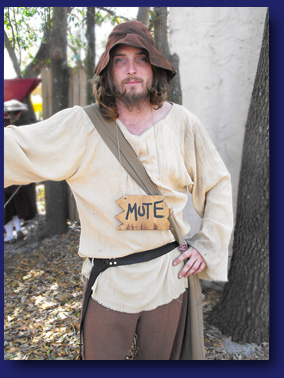 |
 |
|
|
|
Mute
Mouseover photo to see his alter-ego,
Volume |
|
|
Allison
Ally is from Ft. Myers/Port Charlotte, Florida and is
currently obtaining her B.A degree in Speech, Language and Hearing
with a Minor in Sign Language from the University of South Florida.
Visit her
MySpace site |
|














|
